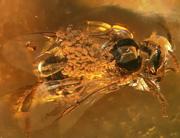 This busy bee was caught carrying a load of pollen.Santiago Ramírez.
This busy bee was caught carrying a load of pollen.Santiago Ramírez.One day, fifteen or twenty million years ago, a bee dropped by an orchid and buried its head deep into the flower for a drink of nectar. A little later, the busy bee set out once again, this time to bring home some resin to help with hive construction. It would be the last errand it would ever run.
Millions of years later, the bee has been found stuck, mid-errand, in amber. It is still clutching a tiny ball of resin, and it carries the first definitive fossil remnant of an orchid ever discovered — a package of pollen from the visited flower.
Santiago Ramírez of Harvard University in Cambridge, Massachusetts, and his colleagues have used that fossilized pollen to unpick the ancestral line of orchids. What is now arguably the world's most diverse floral family probably started with a single common ancestor that existed about 80 million years ago, they find1.
"It's absolutely fantastic," says Kenneth Cameron, an orchid specialist at the New York Botanical Garden. "It's what the orchid community has been waiting for, for a long time."
Avoiding the rot
The orchid community has been desperate for a fossil, any fossil, that is definitely an orchid. Until now, every candidate has been ambiguous. A few flat impressions of leaves, for example, could have been orchids, but they could just as easily have been something else entirely.
Orchids simply don't fossilize well. Their seeds are tiny, dust-like particles, and their pollen degrades easily in the acid often used to extract pollen fossils from rocks. Furthermore, orchids grow in moist habitats that don't favour fossilization, says Norris Williams, a botanist at the Florida Museum of Natural History in Gainesville: "If you're in a wet tropical forest and you fall to the ground, there's a good chance that you're going to rot before you can fossilize."
But when an industrious bee met with the oozings of an ancient tree, all these problems were circumvented. Ramírez and his colleagues could tell immediately that the rough, granular grains of pollen belonged to an orchid.
“The dinosaurs could have walked among orchids.”
Because of the pollen's structure, they could assign the fossil to the orchid subtribe Goodyerinae. It looks particularly like the pollen of two members of that subtribe currently found in the Dominican Republic.
Though most of the Goodyerinae orchids tend to deposit pollen on the heads of visiting insects, one of the modern Dominican orchids drops pollen onto a bee's back. This is where the bee in amber is carrying its cargo.
Flowers for dinosaurs
Once they had identified the orchid, Ramírez and his colleagues could use it to address an old debate about the age of the orchid family.
The absence of orchids in the fossil record and their high degree of specialization meant that some researchers regarded orchids as a relatively recent addition to the repertoire of flowering plants. But their distribution around the world suggested a more ancient history; some have proposed they originated over 100 million years ago.
ADVERTISEMENT
To investigate, the team used genetic information from 55 genera of living orchids to make a family tree, determining which plants are most related to each other today and then working backwards to see when they probably split apart.
By dating the amber of their new fossil find to 15-20 million years ago, they could then start to put dates onto the various branches of this tree. Assuming a relatively constant rate of orchid evolution, the oldest common ancestor of the orchid family probably lived at least 76 million years ago, in the Late Cretaceous period. "The dinosaurs could have walked among orchids," says Ramírez.
Visit our preservesrareorchidpo.html">newsblog to read and post comments about this story.
